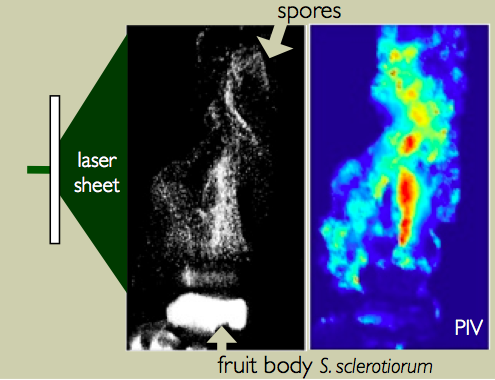| <<< back | Dispersal of explosively launched fungal spores |
|
Hydrodynamic cooperation allows groups of spores to disperse more effectively than single spores. When many spores are ejected simultaneously, they create a wind and travel many times further than singly ejected spores; this wind also enables spores to travel round obstacles (e.g. leaves and branches). This synchronized ejection of hundred of thousands of spores is called "puffing" and is observed in apothecial fungi which represent more than 9000 of the 35 000 described species of Ascomycetes. For example, the pathogen Sclerotinia sclerotiorum, must travel from fruit bodies found at ground level to the flowers of target crops, sometimes more than a meter off of the ground. It has long been known that any single spore decelerates very rapidly after ejection, because of its small size: in still air the typical range of a singly ejected spore is ~4mm. Moreover, singly ejected spores are easily checked by unfavorable airflows or blocked by obstacles.
|
||
|
This is a short presentation of the results in the form of a movie. |
 |
Single spores are ejected from cells called asci, that swell due to osmotic pressure and then explode releasing the spores and all the cytoplasmic fluid. We are interested in modeling this process to ask whether evolution has shaped this pressure gun to its optimal performance. The results have been accepted for publication in the Proc. Roc. Soc. Interface (collaboration with Joerg Fritz, Marcus Roper, Anne Pringle and Michael Brenner).
|
||